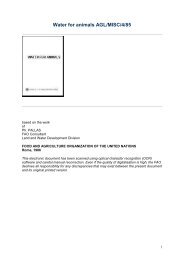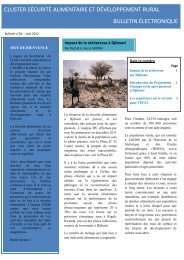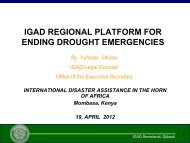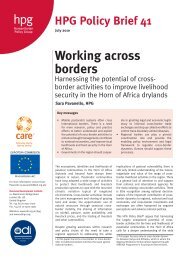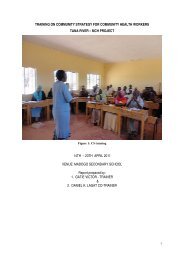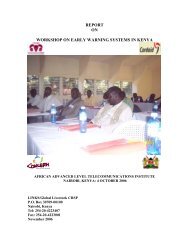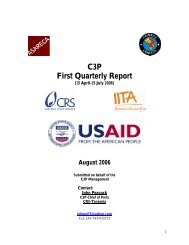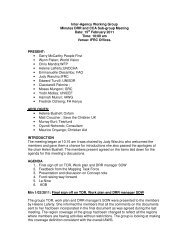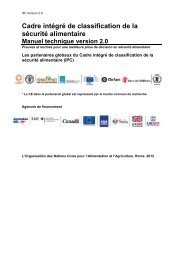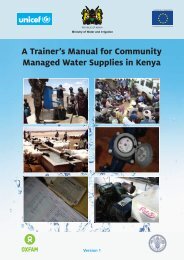Synthesis of Existing Knowledge and Experience on the Provision of ...
Synthesis of Existing Knowledge and Experience on the Provision of ...
Synthesis of Existing Knowledge and Experience on the Provision of ...
Create successful ePaper yourself
Turn your PDF publications into a flip-book with our unique Google optimized e-Paper software.
Dohrn, 2006). Spatially variable rainfall means that <strong>the</strong> locati<strong>on</strong> <str<strong>on</strong>g>of</str<strong>on</strong>g> rainy seas<strong>on</strong> <str<strong>on</strong>g>and</str<strong>on</strong>g> dry seas<strong>on</strong>pastures may vary from year to year (Hell<str<strong>on</strong>g>and</str<strong>on</strong>g>, 1980: 60). To accommodate for this variability, accessfrom rain poor to rain rich territories is ei<strong>the</strong>r allowed or negotiated (if <strong>the</strong> visiting herders areunrelated) between neighbouring groups. This type <str<strong>on</strong>g>of</str<strong>on</strong>g> arrangement helps pastoralists deal withclimatic variability, <str<strong>on</strong>g>and</str<strong>on</strong>g> reciprocity – a key feature <str<strong>on</strong>g>of</str<strong>on</strong>g> pastoral systems – is expected when <strong>the</strong> tablesare turned (Beyene <str<strong>on</strong>g>and</str<strong>on</strong>g> Korf, 2008). Therefore movement between territories is based <strong>on</strong>negotiati<strong>on</strong> <str<strong>on</strong>g>and</str<strong>on</strong>g> reciprocity, <str<strong>on</strong>g>and</str<strong>on</strong>g> traditi<strong>on</strong>al instituti<strong>on</strong>s are in place to represent different clans orgroups in decisi<strong>on</strong>-making regarding access to l<str<strong>on</strong>g>and</str<strong>on</strong>g> <str<strong>on</strong>g>and</str<strong>on</strong>g> water (Thébault, 1995 in Gomes, 2006).Communal tenure cannot <strong>the</strong>refore be equated with ‘free’ or ‘open’ access regimes which lackownership or management plans (Lane, 1996 in Gomes, 2006). In turn, <strong>the</strong> tragedy <str<strong>on</strong>g>of</str<strong>on</strong>g> <strong>the</strong> comm<strong>on</strong>s<strong>the</strong>ory expounded by Hardin in <strong>the</strong> late 1960s, which argues that in such a situati<strong>on</strong> <str<strong>on</strong>g>of</str<strong>on</strong>g> ‘open access’individual herders maximize short term gain through <strong>the</strong> indiscriminate use <str<strong>on</strong>g>of</str<strong>on</strong>g> pastures to increase<strong>the</strong>ir herd size, eventually leading to overgrazing <str<strong>on</strong>g>and</str<strong>on</strong>g> depleted pasture (Hardin, 1968), does notreflect reality in <strong>the</strong> rangel<str<strong>on</strong>g>and</str<strong>on</strong>g>s. However, tragedy <str<strong>on</strong>g>of</str<strong>on</strong>g> <strong>the</strong> comm<strong>on</strong>s thinking has greatly influencedapproaches in <strong>the</strong> early years <str<strong>on</strong>g>of</str<strong>on</strong>g> development in Ethiopia’s lowl<str<strong>on</strong>g>and</str<strong>on</strong>g>s, <str<strong>on</strong>g>and</str<strong>on</strong>g> unfortunately c<strong>on</strong>tinues todo so even though <strong>the</strong> validity <str<strong>on</strong>g>of</str<strong>on</strong>g> <strong>the</strong> <strong>the</strong>ory has been repeatedly challenged.The pastoralist livelihood strategy is still c<strong>on</strong>sidered a highly rati<strong>on</strong>al <str<strong>on</strong>g>and</str<strong>on</strong>g> flexible l<str<strong>on</strong>g>and</str<strong>on</strong>g> use for much<str<strong>on</strong>g>of</str<strong>on</strong>g> <strong>the</strong> arid lowl<str<strong>on</strong>g>and</str<strong>on</strong>g>s, as attested to by <strong>the</strong> persistence <str<strong>on</strong>g>and</str<strong>on</strong>g> performance <str<strong>on</strong>g>of</str<strong>on</strong>g> <strong>the</strong> livelihood in thissetting (where mobility is still practiced relatively unimpeded). Devereux (2006) found that wheremobility is unhindered, pastoral households are more ec<strong>on</strong>omically <str<strong>on</strong>g>and</str<strong>on</strong>g> food secure than <strong>the</strong>irsettled counterparts. In Ethiopia, it was found that livestock are more at risk <str<strong>on</strong>g>of</str<strong>on</strong>g> succumbing todrought in areas where pastoralists are settled into a semi-sedentary lifestyle. In 2004 <str<strong>on</strong>g>and</str<strong>on</strong>g> 2006many pastoral settlements were partially or entirely ab<str<strong>on</strong>g>and</str<strong>on</strong>g><strong>on</strong>ed, as people moved to evade <strong>the</strong>drought (Devereux, 2006). Little et al (2008) reached a similar c<strong>on</strong>clusi<strong>on</strong>, showing that householdswere less likely to lose <strong>the</strong>ir livestock assets <str<strong>on</strong>g>and</str<strong>on</strong>g> become food insecure if <strong>the</strong>y remained mobile.However, certain realities in parts <str<strong>on</strong>g>of</str<strong>on</strong>g> <strong>the</strong> rangel<str<strong>on</strong>g>and</str<strong>on</strong>g>s cannot be ignored, including <strong>the</strong> fact thatpopulati<strong>on</strong> is increasing, that people require diverse livelihood opportunities which may lie outsidepastoral producti<strong>on</strong>, <str<strong>on</strong>g>and</str<strong>on</strong>g> that highl<str<strong>on</strong>g>and</str<strong>on</strong>g> populati<strong>on</strong>s are being resettled to <strong>the</strong> lowl<str<strong>on</strong>g>and</str<strong>on</strong>g>s <str<strong>on</strong>g>and</str<strong>on</strong>g> willrequire livelihood opti<strong>on</strong>s more than likely based <strong>on</strong> agricultural producti<strong>on</strong>. The multiple needs <str<strong>on</strong>g>and</str<strong>on</strong>g>priorities in <strong>the</strong> rangel<str<strong>on</strong>g>and</str<strong>on</strong>g>s must <strong>the</strong>refore be acknowledged, <str<strong>on</strong>g>and</str<strong>on</strong>g> all opti<strong>on</strong>s fully <str<strong>on</strong>g>and</str<strong>on</strong>g> fairly explored(importantly including pastoral producti<strong>on</strong> 12 ) to enhance nati<strong>on</strong>al ec<strong>on</strong>omic growth withoutcompromising sustainable livelihoods.2.2 Challenges facing <strong>the</strong> rangel<str<strong>on</strong>g>and</str<strong>on</strong>g>s <str<strong>on</strong>g>and</str<strong>on</strong>g> pastoral livelihoodsDespite <strong>the</strong> positive c<strong>on</strong>tributi<strong>on</strong>s <str<strong>on</strong>g>of</str<strong>on</strong>g> pastoralism to livelihoods, <strong>the</strong> ec<strong>on</strong>omy <str<strong>on</strong>g>and</str<strong>on</strong>g> to rangel<str<strong>on</strong>g>and</str<strong>on</strong>g>health, <strong>the</strong>re are persistent challenges. These include <strong>the</strong> c<strong>on</strong>tinued degradati<strong>on</strong> <str<strong>on</strong>g>of</str<strong>on</strong>g> <strong>the</strong> rangel<str<strong>on</strong>g>and</str<strong>on</strong>g>s,<strong>the</strong> shrinkage <str<strong>on</strong>g>of</str<strong>on</strong>g> l<str<strong>on</strong>g>and</str<strong>on</strong>g> available for grazing, <str<strong>on</strong>g>and</str<strong>on</strong>g> reduced opportunities for mobility. These challengeshave clear implicati<strong>on</strong>s for pastoral producti<strong>on</strong> <str<strong>on</strong>g>and</str<strong>on</strong>g> for livelihoods. The stubborn encroachment <str<strong>on</strong>g>of</str<strong>on</strong>g>Prosopis juliflora, <strong>the</strong> c<strong>on</strong>tinued excisi<strong>on</strong> <str<strong>on</strong>g>of</str<strong>on</strong>g> key grazing areas for irrigati<strong>on</strong> expansi<strong>on</strong> (see Box 1) <str<strong>on</strong>g>and</str<strong>on</strong>g>o<strong>the</strong>r uses such as nati<strong>on</strong>al parks <str<strong>on</strong>g>and</str<strong>on</strong>g> crop cultivati<strong>on</strong> (<strong>the</strong> latter by some pastoralists, as well asimmigrants <str<strong>on</strong>g>and</str<strong>on</strong>g> refugees), <strong>the</strong> proliferati<strong>on</strong> <str<strong>on</strong>g>of</str<strong>on</strong>g> pasture enclosures for private use, increasedsedentarizati<strong>on</strong> <str<strong>on</strong>g>and</str<strong>on</strong>g> <strong>the</strong> proliferati<strong>on</strong> <str<strong>on</strong>g>of</str<strong>on</strong>g> water points which promote settlement, <str<strong>on</strong>g>and</str<strong>on</strong>g> poor rangel<str<strong>on</strong>g>and</str<strong>on</strong>g>management all c<strong>on</strong>tribute to <strong>the</strong> persistence <str<strong>on</strong>g>of</str<strong>on</strong>g> <strong>the</strong>se problems. Increasing populati<strong>on</strong>, poverty,c<strong>on</strong>flict, frequent drought, <str<strong>on</strong>g>and</str<strong>on</strong>g> policies which promote sedentarizati<strong>on</strong> exacerbate <strong>the</strong> challenges.These c<strong>on</strong>diti<strong>on</strong>s have been associated with decreased per capita holdings <str<strong>on</strong>g>of</str<strong>on</strong>g> livestock, <str<strong>on</strong>g>and</str<strong>on</strong>g> anincreased trend towards agro-pastoralism am<strong>on</strong>g Ethiopia’s pastoral communities (Yemane, 2003).Fur<strong>the</strong>rmore, <strong>the</strong> numbers <str<strong>on</strong>g>of</str<strong>on</strong>g> pastoral dropouts – those who have lost <strong>the</strong>ir livestock assets <str<strong>on</strong>g>and</str<strong>on</strong>g> do12 For example, <strong>the</strong> Oromia regi<strong>on</strong>al government’s prominent Oromia Growth Corridors Plan has declaredthat a large porti<strong>on</strong> <str<strong>on</strong>g>of</str<strong>on</strong>g> pastoral l<str<strong>on</strong>g>and</str<strong>on</strong>g> in Oromia should be maintained as rangel<str<strong>on</strong>g>and</str<strong>on</strong>g> <str<strong>on</strong>g>and</str<strong>on</strong>g> should not be c<strong>on</strong>vertedfor agriculture.25



